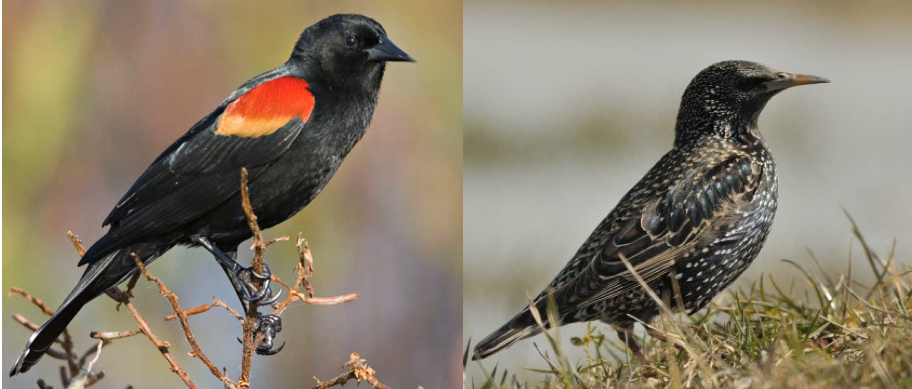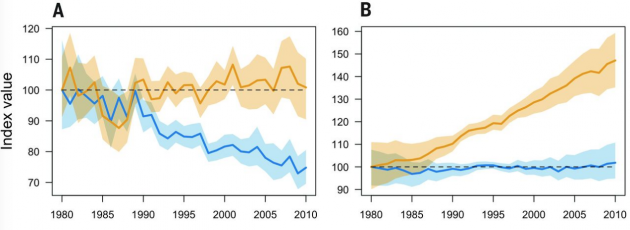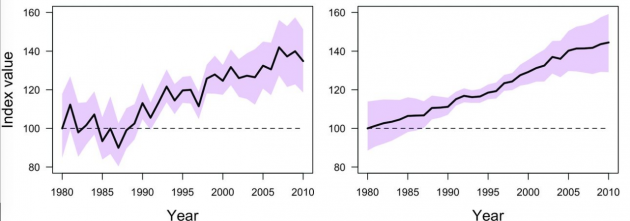
I want to alert you to a recent study (from April) that looks at the plight of bird populations under conditions of climate change in Europe and North America.
The study looked at common birds, and used data divided by either state (in the US) or country (in Europe). Data were collected from the North American Breeding Bird Survey and the Pan-European Common Birds Monitoring Scheme.
From the Abstract and summary:
Changes in climate can cause populations of species to decline, to increase, or to remain steady. Stephens et al. looked across species of common birds in Europe and the United States. Despite many differences between the two regions, expectations about how a species might respond to climate change did predict actual responses. Species predicted to benefit from increasing temperatures, or their associated effects, tended to increase, whereas those predicted to be negatively affected declined. …
… We used long-term monitoring of the abundance of breeding birds across Europe and the United States to produce, for both regions, composite population indices for two groups of species: those for which climate suitability has been either improving or declining since 1980. The ratio of these composite indices, the climate impact indicator (CII), reflects the divergent fates of species favored or disadvantaged by climate change. The trend in CII is positive and similar in the two regions. On both continents, interspecific and spatial variation in population abundance trends are well predicted by climate suitability trends.
Stephens, Philip, et al. 2016. Consistent response of bird populations to climate change on two continents. Science. 352:6281(84-87).
The process of analysis was complex, but the result is fairly simple. Bird populations were measured for each state or country over time (1980 – 2010) do track increases or decreases. Two primary indices were derived, the Climate Suitability Trend Negative (CST-) and the Climate Suitability Trend Positive (CST+). These indices were derived using the species abundance data independently by state/country, so a given bird species might contribute to both measures. This is a novel approach that solves the problem of different subregions of a bird’s range, and the birds in that subregion, responding very differently to changing climate because of geographical or ecological factors, or bird-bird interaction, etc.
Climate change can increase a bird’s population and range, or decrease it. It isn’t necessarily the case that one is good and one is bad. For example, if a highly competitive common bird species expands its range into a region where local, more rare species exist, they could get pushed out. In essence, in ecology, all change is bad in a way, even though change can contribute ultimately to increased diversity of something. Short and medium term both increasing and decreasing abundance, when they happen together, lead to decreased biodiversity.
A third index was also derived, which is, essentially, the CST+ combined with the CST-. Let’s look at that first.
They are essentially the same. The total overall impact on bird populations, related to climate change, is the same in North America (on the right) and Europe (on the left). The difference in the jitteryness of the lines has to do with sample size. There are way more North American birds in the sample than European, owing to differences in the quality of the data. The larger North American sample sizes smooth out the line.
But when we look at the CLT+ and CLT- data separately, a very different picture emerges.

Again, Europe is on the left, North America is on the right.
The orange line is the CLT+, meaning, the cases where bird populations are expanding under climate change, and the blue line is the CLT-. In essence, the benefits to birds from climate change (global warming caused by human release of greenhouse gas pollution) is neutral, while the negative effects are serious and increasing. In North America, the positive effects (on population size) are large and increasing, while the negative effects are neutral.
Put a slightly different way, Europe has the problem of declining population sizes of many bird species, while North America as represented by the US has fewer problems with declining species but a different problem, with some species expanding their population size.
Reminder: This study looked at the more common species. This does not indicate, one way or another, anything about small and rare populations.
Why are Europe and North America different?
I have a few ideas. One is that they two regions are very different ecologically. Europe is shifted a bit father north geographically, but is shifted father south ecologically, as it is warmed by Atlantic heat. The dry regions in the southern extent of the studied zone is greater in North America, but the more southerly, outside the study area dry zone is huge in Europe compared to the North America study (North Africa vs. Mexico). The distribution of mountains and low areas and rivers and everything is totally different. Heck, I’ve even heard that half the rivers in Europe flow North!
So, physical geography and topography, and overall climate differences, could explain something here.
There is a second kind of difference as well. The US has probably experienced a very different set of effects from climate change, owing to the configurations of the jet streams and trade winds, compared to Europe. For example, we have not experienced the heat waves Europe has, though both regions have experienced major floods. Heat waves probably bother birds a lot more than floods do.
What do you think? What about the birds and their habitats in the two regions would explain this pattern?














The Science article and supplementary material refer to the US. Is there additional material to support the extension to “North America”?
Eric, I was wondering the same thing. This is a comparison between US and a big chunk of Europe, though they use the term “North America.”